|
||||||||||
|
|
||||||||||
|
||||||||||
|
|
||||||||||
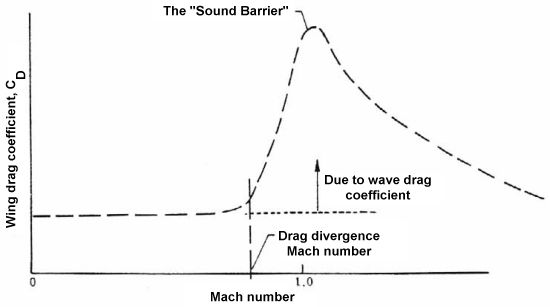
Since the physics of supersonic flight were still largely a mystery to manufacturers, designers had no idea how to address this problem except to provide their aircraft with more powerful engines. Even though jet engine technology was rapidly advancing in those days, the first generation of jet-powered fighters was hampered by relatively low-thrust engines which limited them to subsonic flight. The US Air Force hoped to overcome this deficiency with its first dedicated supersonic fighter, the F-102 Delta Dagger.
Since the transonic drag rise was still not fully understood, the F-102's designers chose an engine they believed would provide enough thrust to reach a maximum speed of about Mach 1.2. However, initial flight tests of the YF-102 prototype indicated that the aircraft couldn't even reach Mach 1. The Convair engineers were baffled by this lack of performance until a NACA researcher named Dr. Richard Whitcomb developed the area rule.
Whitcomb experimented with several different axisymmetric bodies and wing-body combinations in a transonic wind tunnel. What he found was that the drag created on these shapes was directly related to the change in cross-sectional area of the vehicle from the nose to the tail. The shape itself was not as critical in the creation of drag, but the rate of change in that shape had the most significant effect. For the mathematically inclined, we can say that wave drag is related to the second-derivative (or curvature) of the volume distribution of the vehicle.
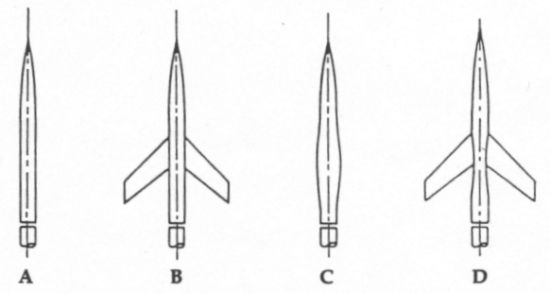
To illustrate the point, four of Whitcomb's experimental models are drawn above, representing a simple cylindrical fuselage, the same fuselage with wings attached, a bulged fuselage, and a "pinched" fuselage with wings. What Whitcomb discovered was that the addition of wings to the basic cylinder produced twice as much drag as the cylinder alone. He also found that drag rose by the same amount if a simple bulge were added to the cylinder, the bulge being of equivalent volume as the wings. However, if he reduced the cross-sectional area of the fuselage over the region were the wings were attached, shown as body "D," the total drag was about the same as that of the cylinder alone.
The conclusion of this research was that shaping the vehicle to create a smooth cross-sectional area distribution from the nose to the tail could drastically reduce the drag on an aircraft. The area rule tells us that the volume of the body should be reduced in the presence of a wing, tail surface, or other projection so that there are no discontinuities in the cross-sectional area distribution of the vehicle shape.
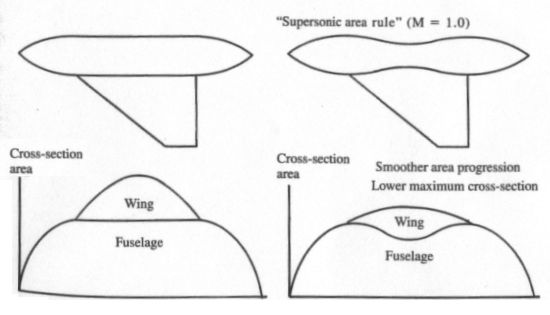
Whitcomb's findings are related to a more theoretical concept called the Sears-Haack body. This shape yields the lowest possible wave drag for a given length and volume. The variation in cross-sectional area for a Sears-Haack body, illustrated in the following figure, tells us that wave drag is minimized when the curvature of the volume distribution is minimized. The closer the volume distribution of an aircraft or other high-speed vehicle comes to the ideal Sears-Haack body, the lower its wave drag will be.
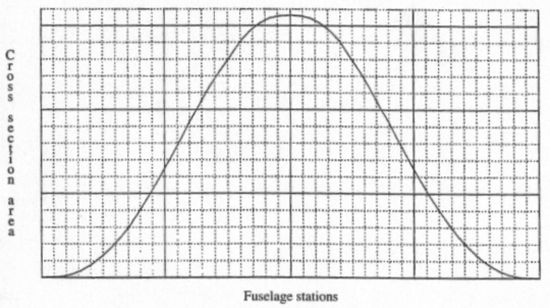
Whitcomb's research was a major breakthrough in supersonic aerodynamics and had an immediate effect on the design of the aforementioned F-102 fighter. Convair engineers quickly redesigned the aircraft's fuselage, taking the area rule concept into account, to create the "waisted" or "coke-bottle" fuselage. This modification, plus a new engine, allowed the aircraft to easily exceed Mach 1 and achieve a maximum speed over Mach 1.5.
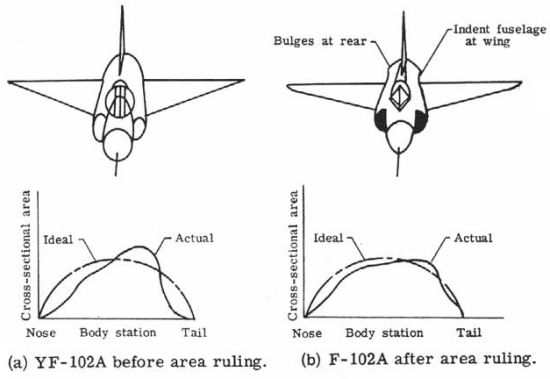
Today's supersonic fighters are fitted with much more powerful engines than were available in the 1950s, so the
area rule is not as essential to their design as it used to be. However, it has found greater application to
subsonic aircraft, particularly commercial airliners since they cruise at the lower end of the transonic regime.
A good example is the Boeing 747, known for its distinctive
"hump." This hump, which houses the cockpit and upper passenger deck, increases the cross-sectional area of the
forward fuselage and has the effect of evening the volume distribution over the length of the aircraft. As a
result, the 747 is able to cruise efficiently at a slightly higher speed than most other airliners since the
increase in transonic wave drag is delayed.
- answer by Jeff Scott, 24 November 2002
Related Topics:
Read More Articles:


|
Aircraft | Design | Ask Us | Shop | Search |

|
|
| About Us | Contact Us | Copyright © 1997- | |||
|
|
|||